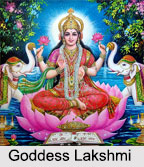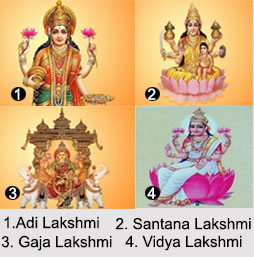 Goddess Lakshmi is believed to bring good luck and cares for her devotees from different kinds of unhappiness and economical problems. According to the Hindu Mythology, Owl is her carrier. However, while travelling with Lord Vishnu she travels on an Eagle. An owl is blind during the day and a rich person who lacks the right intellect cannot see beyond his affluence. Eagle represents wisdom. Whenever she travels without Lord Vishnu the person whom she visits is made symbolically sightless. Hindus consider Goddess Lakshmi as good fortune. The word "Lakshmi" is originated from the Sanskrit word "Laksya", that means aim.
She is portrayed as restless, unusual yet motherly, with her arms raised to bless and to allowance.
Goddess Lakshmi is believed to bring good luck and cares for her devotees from different kinds of unhappiness and economical problems. According to the Hindu Mythology, Owl is her carrier. However, while travelling with Lord Vishnu she travels on an Eagle. An owl is blind during the day and a rich person who lacks the right intellect cannot see beyond his affluence. Eagle represents wisdom. Whenever she travels without Lord Vishnu the person whom she visits is made symbolically sightless. Hindus consider Goddess Lakshmi as good fortune. The word "Lakshmi" is originated from the Sanskrit word "Laksya", that means aim.
She is portrayed as restless, unusual yet motherly, with her arms raised to bless and to allowance.
Origin of Goddess Lakshmi
Goddess Lakshmi is the daughter of Sage Bhrigu. When Gods were banished due to the curse of the sage Durvasa that all Gods would lose their supremacy, she took shelter in ocean. For gaining immortality and defeating the asuras, the gods started whipping the ocean in search of a powerful elixir, Amrit which would present them immortality, splendour and massive power.
While churning the ocean, there were many treasures that shelled and goddess Lakshmi was one of them. She took the reincarnation from the process and came out with a wreath which she used to choose Lord Vishnu denoting him as the heavenly consort and helping him to keep up the universe"s wealth. Narration in Vishnu Purana explains that Goddess Lakshmi had to leave swarga due to the curse of Durvasa and live in Ksheersagara.
Iconography of Goddess Lakshmi
 Goddess Lakshmi is portrayed as a gorgeous woman of golden skin tone, with four hands, sitting or standing on a full-bloomed lotus and holding a lotus blossom, which stands for beauty, wholesomeness and fruitfulness. Her four hands symbolize the four ends of human life: dharma or virtue, "kama" or desires, "artha" or wealth and "moksha" or liberation from the cycle of birth and death. The cascades of gold coins are seen flowing from her hands, suggesting that those who worship her put on wealth. She always wears gold embroidered red clothes. Red symbolizes motion and the golden lining shows affluence.
Goddess Lakshmi is portrayed as a gorgeous woman of golden skin tone, with four hands, sitting or standing on a full-bloomed lotus and holding a lotus blossom, which stands for beauty, wholesomeness and fruitfulness. Her four hands symbolize the four ends of human life: dharma or virtue, "kama" or desires, "artha" or wealth and "moksha" or liberation from the cycle of birth and death. The cascades of gold coins are seen flowing from her hands, suggesting that those who worship her put on wealth. She always wears gold embroidered red clothes. Red symbolizes motion and the golden lining shows affluence.
Two elephants are often shown standing next to the goddess and drenching water. This represents the constant endeavour, in accordance with one`s dharma and directed by wisdom and cleanliness, leads to both material and spiritual wealth.
She is famous as to be very strongly associated with the lotus and her other names include: Manushri, Chakrika, Kamalika, Aishwarya, Lalima, Kalyani, Nandika, Rujula, Vaishnavi, Samruddhi, Narayani, Bhargavi, Sridevi, Chanchala, Jalaja, Madhavi, Sujata, Shreya. She is also referred as the Jaganmaatha in Shri Mahalakshmi Ashtakam. Lakshmi is called Sri or Thirumagal because she is capable with six favourable and heavenly qualities or Gunas and also because she is the source of strength even to Vishnu.
Forms of Goddess Lakshmi
Goddess Lakshmi has eight different forms. This concept of Goddess Lakshmi in her eight forms is referred to as the "Ashta-Lakshmi". The eight heavenly forms of Goddess Lakshmi or Ashta-Lakshmi contain:
•Aadi-Lakshmi (The Primeval Goddess) or Maha Lakshmi (The Great Goddess)
•Dhana-Lakshmi or Aishwarya Lakshmi (The Goddess of Prosperity and Wealth)
•Dhaanya-Lakshmi (Goddess of Food Grains)
•Gaja-Lakshmi (The Elephant Goddess)
•Santana-Lakshmi (The Goddess of Progeny)
•Veera-Lakshmi or Dhairya Lakshmi (The Goddess of Valor and Courage)
•Vidya-Lakshmi (The Goddess of Knowledge)
•Vijaya-Lakshmi or Jaya Lakshmi (The Goddess of Victory)
Worshipping of Goddess Lakshmi
Most of the Hindus worship Goddess Lakshmi on Diwali. It is famous in autumn, characteristically in October or November annually. The festival religiously signifies the triumph of light over darkness, knowledge over unawareness, good over evil and hope over misery. Before Diwali night, people clean, repair and decorate their homes and offices. On Diwali night, Hindus dress up in new clothes or their best outfits, light up diyas within and outside their home and take part in family puja. After the puja, fireworks follow, then a family feast including sweets and an exchange of gifts between the family members and close friends. This festival is dedicated to Lakshmi which is considered by Hindus to be one of the most significant and cheerful festivals of the year.
Gaja Lakshmi Puja is another autumn festival celebrated on Sharad Purnima in several parts of India on the full-moon day in the month of Ashvin. Sharad Purnima is also called the Kojaagari Purnima or Kuanr Purnima which is a crop festival marking the end of monsoon season. There is a traditional celebration of the moon called the Kaumudi celebration, Kaumudi meaning moonlight. On Sharad Purnima night, goddess Lakshmi is thanked and worshipped for the harvests. Numerous mantras, prayers, shlokas, stotra, songs and legends devoted to Mahalakshmi and are performed during the ceremonial worship of Lakshmi.
These include Sri Mahalakshmi Ashtakam, Sri Lakshmi Sahasaranama Stotra, Sri Stuti, Sri Lakshmi Stuti by Indra, Sri Kanakadhara Stota, Sri Chatussloki, Sri Lakshmi Sloka and Sri Sukta, which is contained in the Vedas. Sri Sukta contains Lakshmi Gayatri Mantra.









